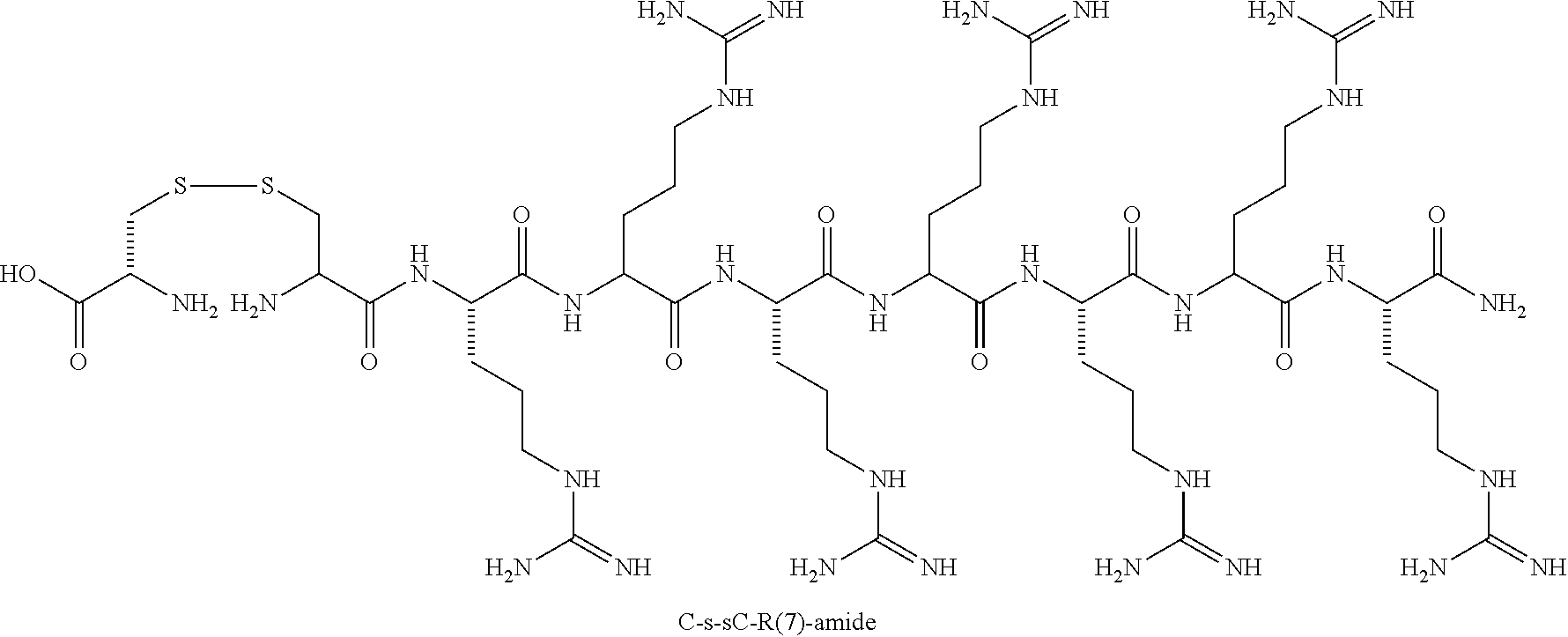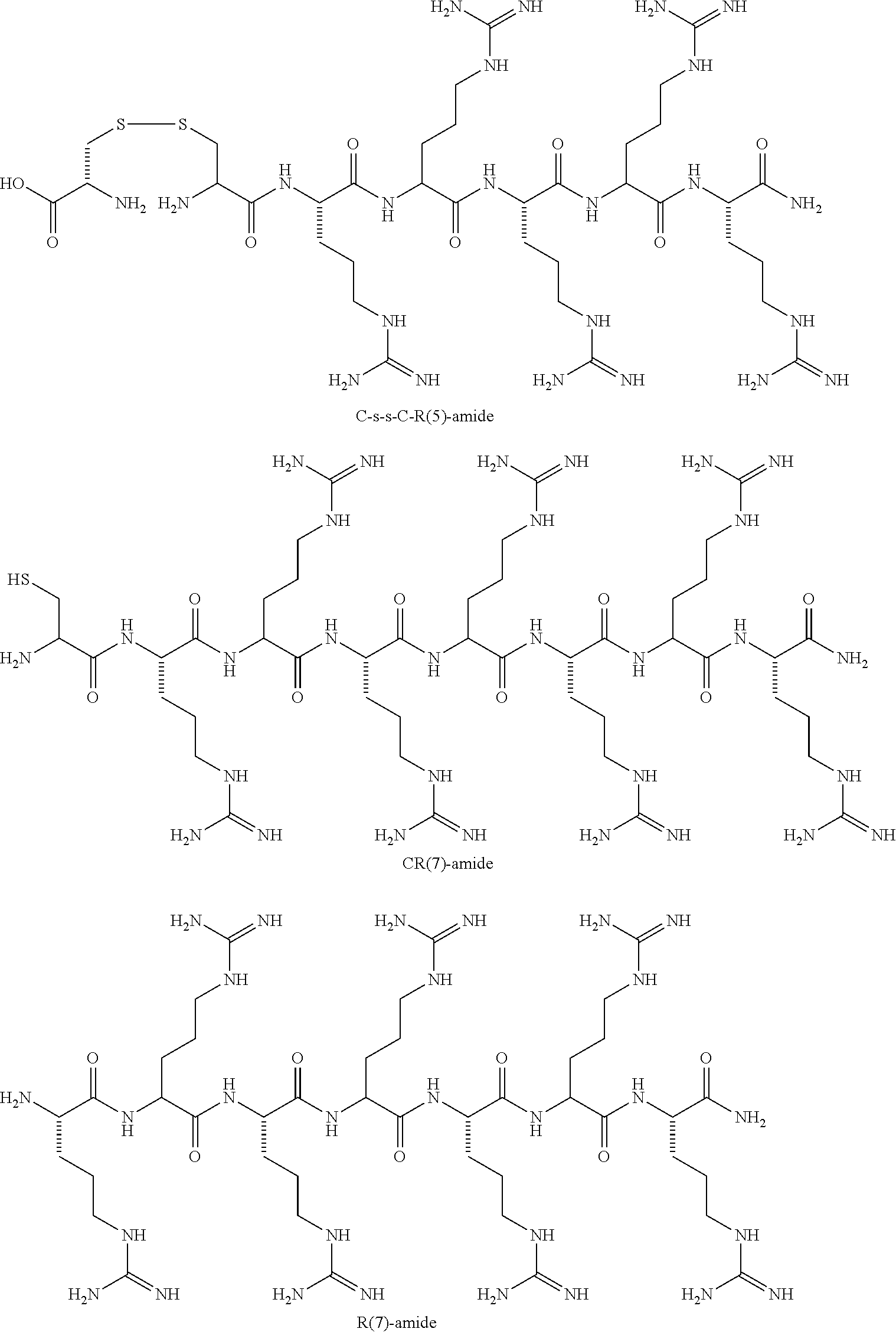Neuroprotective composition and method of use
a composition and neuroprotective technology, applied in the field of polyarginine and polyarginine/cysteine compositions, can solve the problems of inability to move one or more limbs on one side of the body, permanent dysfunction/damage of the brain, difficulty in understanding or formulating speech,
- Summary
- Abstract
- Description
- Claims
- Application Information
AI Technical Summary
Benefits of technology
Problems solved by technology
Method used
Image
Examples
example 1
Stroke Patient
[0068]A 57 year old male enters the emergency room and is diagnosed with an ischemic event involving the middle cerebral artery, with symptomatology onset being under 1 hr. Immediately, the patient was administered an i.v. supplemented with poly-arginine (R(7)C-s-s-C, 5 mg / kg) while blood supply to the restricted area is restored.
[0069]Daily testing of cognitive and motor systems show no deficits in physical or mental capacities. In addition, CT / MRI imaging show no signs of lesioning in the affected region, immediately following recovery and that this was maintained and confirmed by follow-up imaging and behavior testing.
example 2
Post-Stroke Patient
[0070]A 64 year old woman is revived following stoke in her home by EMS and is rushed to the nearest hospital 80 miles away. Upon arriving at the hospital it is determined that the patient is showing signs of weakness on her left side. In addition she complains of having blurred vision and exhibits difficulty in speaking clearly. She is immediately started an i.v. and administered poly arginine (R(7))@ 4 mg / kg / hr over a period of 5 days to arrest post-stroke neuronal damage. The patient is monitored for recovery signs. Improvement in her speech pattern is noted over the next 30 days as is increased muscle tone on the left side and muscle recovery strength and usage of her effected limbs.
example 3
TBI Patient
[0071]A 17 year old high school football player is rushed to the emergency room of a local hospital suffering from a severe concussion following a helmet to helmet impact with an opposing player. The patient is initially unconscious on the field for over 20 min. EMS personnel arrived to find the patient responding to stimuli, but completely disoriented and unable to coordinate muscle movement, articulate speech or focus eye movements. Upon arriving at the ER, the patient is administered an i.v. containing R(7)C-s-s-C peptide at 0.05 mg / kg. Delivery of the peptide continued until brain swelling resulting from the impact returns to normal state (3-5 days). Without being bound by any particular theory, the therapeutic is to arrest neuronal cell death resulting from these documented post-traumatic effects. Monitoring the patient though this period (and beyond) shows that he remains symptom free of TBI and post-concussion effects (i.e. avoiding short-term memory loss or exhibi...
PUM
| Property | Measurement | Unit |
|---|---|---|
| Dimensionless property | aaaaa | aaaaa |
| Dimensionless property | aaaaa | aaaaa |
| Therapeutic | aaaaa | aaaaa |
Abstract
Description
Claims
Application Information
 Login to View More
Login to View More - R&D
- Intellectual Property
- Life Sciences
- Materials
- Tech Scout
- Unparalleled Data Quality
- Higher Quality Content
- 60% Fewer Hallucinations
Browse by: Latest US Patents, China's latest patents, Technical Efficacy Thesaurus, Application Domain, Technology Topic, Popular Technical Reports.
© 2025 PatSnap. All rights reserved.Legal|Privacy policy|Modern Slavery Act Transparency Statement|Sitemap|About US| Contact US: help@patsnap.com


